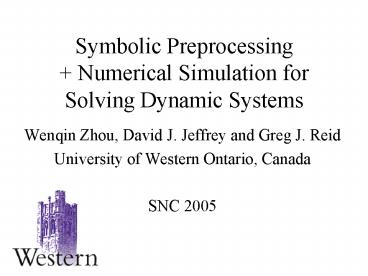Symbolic Preprocessing Numerical Simulation for Solving Dynamic Systems - PowerPoint PPT Presentation
1 / 13
Title:
Symbolic Preprocessing Numerical Simulation for Solving Dynamic Systems
Description:
Symbolic Preprocessing Numerical Simulation for. Solving Dynamic Systems ... Advantages after symbolic preprocessing: Find out all hidden constraints for DAE system. ... – PowerPoint PPT presentation
Number of Views:33
Avg rating:3.0/5.0
Title: Symbolic Preprocessing Numerical Simulation for Solving Dynamic Systems
1
Symbolic Preprocessing Numerical Simulation
for Solving Dynamic Systems
- Wenqin Zhou, David J. Jeffrey and Greg J. Reid
- University of Western Ontario, Canada
- SNC 2005
2
Outline
Part III
Part I
Part II
Numerical Simulation
Multibody Dynamic Systems
Symbolic Preprocessing
DynaFlex
Method 1 Implicit Rif Method 2 Explicit Rif
with Hierarchical Representations
Numerical Integration with H.R.
3
Part I Multibody Dynamic systems and DynaFlex
Models
- Multibody Dynamic systems
- open-loop systems 3d top, double pendulum,
etc - closed-loop systems 2d slider crank, 4 bar
system, etc. - General high index DAE system from DynaFlex Shi,
McPhee, 2002 - Open-loop ? without constraints
- Closed-loop ? with constraints
4
Part II Symbolic Preprocessing ----
Differentiation and Elimination method
DAE/PDAE System
Define a ranking , classify the whole system
L0
N0
Solve L0 for their highest derivatives
Differentiate N0
Eliminate w.r.t. L0 and N0
0
0
RIF Form
5
Part II Symbolic Preprocessing---- Advantages
and Disadvantages
- Advantages after symbolic preprocessing
- Find out all hidden constraints for DAE system.
- Easily give consistent initial conditions for
numerical integration and real-time simulation. - Easy to get physical insight into the system.
- Problems when doing symbolic preprocessing
- Intermediate expression swell problems.
- Output expression swell problems.
6
Part II Symbolic Preprocessing---- Problems and
Solutions
- Problem 1 Intermediate expression swell
- One solution Implicit RIF form
- Benefits Avoid symbolic matrix inversion but
have all the hidden
constraints - Problem 2 Output expression swell
- One solution Hierarchical Representations
- Benefits Speed up the whole computation and
the output is more compact.
7
Part II Symbolic Preprocessing -----
Implicit RIF form
- Implicit RIF form Let be a ranking, a
system - is said to be in implicit reduced
involutive form if (1) there exist derivatives
such that is leading linear in
with respect to (i.e.
) (2) -
- is in reduced involutive form. Zhou,
Jeffrey, Reid, Schmitke, McPhee, 2005 - Proposition All hidden constraints, consistent
ICs, can alleviate large expression problems.
8
Part II Symbolic Preprocessing---- hierarchical
representations
- Hierarchical representations is an ordered
list - of symbols, together with an
associated list - of definitions of the symbols. For
each with , there is a definition
of the form - and each is a symbol
in and is thus lower in the
hierarchy than . Corless, Jeffrey, Monagan,
Pratibha, 1996 - We use LU decomposition in hierarchical
representations to do matrix inversions.
9
Part II RIF form in Hierarchical Representations
- Our LU decomposition in hierarchical
representations will be explained in detail in
our ACA talk in the session Handling Large
Expressions in Symbolic Computation. - Advantages for RIF form in hierarchical
representations - Better form for numerical integration
- Speed up the intermediate symbolic computation
and whole computation. - The output is more compact.
- More complex systems can be solved by our LU
decomposition with hierarchical representations.
10
Numerical integration with Hierarchical
Representations
- How to do the numerical integration with H. R.?
- Use the codegen package to make a procedure for
the numeric integration - Set up hierarchical representations to pass to
dsolve/numeric command. - Given the initial conditions which are consistent
with all constraints we found, do the numeric
integration and simulation. - Numerical integration with hierarchical
representations avoid the memory problem caused
by doing expansions.
11
An example 2d slider crank
Fig1 The two-dimensional slider crank. The arm
of length and mass rotates and causes
the mass attached to the end of the arm of
length to move left and right. Each arm has
mass and moment of inertia , for
.
- The model from DynaFlex is
with the algebraic - constraints . (See Maple worksheet for
details)
12
For the 2d slider crank we will do
- Step 1 Compute Implicit RIF form, getting
all hidden constraints - Step 2 Compute RIF form in hierarchical
representations - Step 3 Numerical integration with
hierarchical representations - Step 4 Simulation with different consistent
initial conditions.
13
- Reference
- 1 W. Zhou, D. J. Jeffrey, G. J. Reid. An
Algebraic Method for Analyzing Open-Loop Dynamic
Systems, ICCS 2005, LNCS 3516, pp. 586-593, 2005 - 2 W. Zhou, D.J. Jeffrey, G.J. Reid, C.
Schmitke, J. McPhee. Implicit Reduced Involutive
Forms and Their Application to Engineering
Multibody Systems, IWMM 2004, LNCS 3519, pp.
31-43, 2005. - 3 A.D. Wittkopf, G.J. Reid. The Reduced
Involutive Form Package. Maple Software Package.
First distributed as part of Maple 7, 2001. - 4 R. M. Corless, D. J. Jeffrey, M. B. Monagan,
Pratibha.Two Perturbation Calculations in Fluid
Mechanics Using Large-Expression Management, J.
S. C., 11, pp. 1-17, 1996. - 5 P. Shi, J. McPhee. DynaFlex Users Guide,
Systems Design Engineering, University of
Waterloo, 2002.































